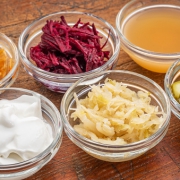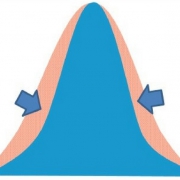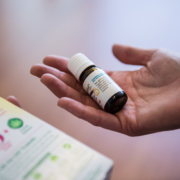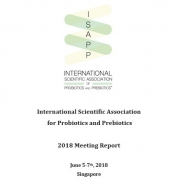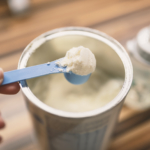Definition of postbiotics: A panel debate in Amsterdam
By Dr. Gabriel Vinderola, PhD, Associate Professor of Microbiology at the Faculty of Chemical Engineering from the National University of Litoral and Principal Researcher from CONICET at the Dairy Products Institute (CONICET-UNL), Santa Fe, Argentina.
A panel debate titled “Postbiotics, definition and scopes” was convened at the 9th Beneficial Microbes conference in Amsterdam on November 14, 2022. The aim of this panel was to advance the discussion about postbiotics in the aftermath of some published disagreement (see here and here) about the definition of postbiotics produced and published by ISAPP: “a preparation of inanimate microorganisms and/or their components that confers a health benefit on the host”. The debaters included Prof. Seppo Salminen and myself (Dr. Gabriel Vinderola), both members of the board of directors of ISAPP and co-authors of the ISAPP postbiotics definition, supporting the ISAPP definition, and Prof. Lorenzo Morelli (in attendance virtually) and Dr. Guus Roeselers challenging the ISAPP definition. The debate was attended by around 150 persons, and consisted of 15-minute opening arguments on both sides, followed by a 30 min open discussion guided by the conference chair, Dr. Koen Venema.
I introduced ISAPP as a non-profit organization dedicated to advancing the science on probiotics, prebiotics and related substances. Among many other activities, ISAPP has produced 5 different consensus definitions: probiotics, prebiotics, synbiotics, postbiotics and fermented foods. Each consensus panel was composed of academic scientists with different backgrounds, expertise and perspectives, comprising at least 11 authors from 4 – 10 countries, who came together to incorporate broad perspectives and engage in thoughtful debate. To date, all 5 consensus papers have had almost half a millon accesses at Nature Reviews Gastroentetology and Hepatology, the journal where all of the definitions are published.
The discussion within ISAPP about the need for a postbiotic definition dates back to our 2019 annual meeting. Emerging research on the health benefits conferred by non-viable microbes, their fragments and metabolites was discussed at the meeting, and this planted the seed for a definition that would cover this area. Many different terms such as heat-killed probiotics, heat-treated probiotics, heat-inactivated probiotics, tyndallized probiotics, paraprobiotics, ghost probiotics, cell fragments, cell lysates and postbiotics had been used to encompass these substances.
The panel discussed these different terms and previously published definitions. Those opposed to the ISAPP definition preferred the Tsilingiri and Rescigno (2013)1 definition of postbiotics, which focuses on metabolites produced by probiotics. I reviewed the limitations of that definition, which were outlined in Salminen et al. (2021)2. One concern is that requiring a postbiotic to be derived from a probiotic creates an unnecessary burden of first meeting the criteria for a probiotic before developing a postbiotic.
Morelli emphasized the importance of definitions for regulatory bodies and stated that researchers should provide guidance on criteria to meet a definition. He quoted the first published definition of postbiotic by Tsilingiri and Rescigno in 20131: “any factor resulting from the metabolic activity of a probiotic or any released molecule capable of conferring beneficial effects to the host in a direct or indirect way”. Morelli stated that one value of this definition was that it was clear to regulators; metabolites are measurable and produced by microbes already accepted as food components with a long history of safe use. He considered this of paramount relevance as otherwise, the novel foods path would be required. He challenged the ISAPP approach as defining a substance that was unclear how to measure. Morelli showed pictures depicting the deterioration of the biomass of freeze-dried cultures during storage, to underscore the challenges of controlling the quality of products based on biomass of non-viable microbes. He added, “If we don´t know which are the components responsible for the health benefits, then it is challenging to determine what to measure.” He questioned the ability to establish the shelf life of such a product. The need to be precise in terms of how to quantify the active components of non-viable cells was essential to his criticism of ISAPP’s definition of postbiotics. Prof. Morelli concluded that researchers must address this issue of quantification methods, both to advance research and to provide regulatory bodies needed approaches to regulating non-viable microbes.
Conclusions from the debate were that the flaws of definitions previous to the ISAPP definition are apparent, and that the substance defined by ISAPP was useful to delineate, but that clear approaches to measurement of the active component(s) of non-viable microbes are needed to make the ISAPP definition workable in scientific and regulatory circles. The debate was very worthwhile, since science advances through respectful debates such as this.
It is clear that characterization of postbiotic products may be challenging, especially with increased complexity that arises by use of multiple inanimate strains, inclusion of metabolic endproducts, and the presence of whole and fragmented cells. But these challenges are not unique to postbiotics. Probiotic products can comprise complex mixtures of multiple strains as well as metabolic products (as the biomass during industrial production is harvested for freeze-drying, but not washed), along with significant amounts of non-viable microbes, which all may contribute to the overall health benefit. These facts are usually overlooked when relying just on viable cells for quantification.
Many commercial products carrying inanimate microbes and metabolic fermentation products, that potentially fit the ISAPP definition of postbiotics, are already available in the market. These are diverse products such as a mixture of two lactobacilli aimed at treating infant and adult diarrhea3 or a fermented infant formula to support pediatric growth4. Similar products also target animal nutrition5. A tightly controlled manufacturing process may be the path forward to warrant reproducibility of health benefits. Suitable characterization methodologies such as flow cytometry for non-viable microbes and mass spectrometry for metabolites seem to be relevant to sufficient postbiotic product characterization.
In brief, the ISAPP definition itself seemed well accepted by the meeting participants, but concerns were raised about how to quantify postbiotics according to the definition. We intend to address this point through consultations with experts, proposing scientific paths to help conceptualize factors that need to be considered for postbiotic quantification.

Panel debate about ISAPP’s definition of postbiotics held at Beneficial Microbes conference in Amsterdam on November 14th, 2022. On the stage, from left to right: Koen Venema (conference chair), Gabriel Vinderola, Seppo Salminen, Guus Roeselers and Lorenzo Morelli (on screen).
References
- Tsilingiri, K. & Rescigno, M. Postbiotics: What else? Benef. Microbes (2013) doi:10.3920/BM2012.0046.
- Salminen, S. et al. The International Scientific Association of Probiotics and Prebiotics (ISAPP) consensus statement on the definition and scope of postbiotics. Nat. Rev. Gastroenterol. Hepatol. (2021) doi:10.1038/s41575-021-00440-6.
- Malagón-Rojas, J. N., Mantziari, A., Salminen, S. & Szajewska, H. Postbiotics for Preventing and Treating Common Infectious Diseases in Children: A Systematic Review. Nutrients 12, (2020).
- Béghin, L. et al. Fermented infant formula (with Bifidobacterium breve C50 and Streptococcus thermophilus O65) with prebiotic oligosaccharides is safe and modulates the gut microbiota towards a microbiota closer to that of breastfed infants. Clin. Nutr. 40, 778–787 (2021).
- Kaufman, J. D. et al. A postbiotic from Aspergillus oryzae attenuates the impact of heat stress in ectothermic and endothermic organisms. Sci. Rep. 11, 6407 (2021).
Additional reading:
Postbiotics: The concept and their use in healthy populations
Watch / listen to the debate here: https://youtu.be/pATNfhQY4P4


